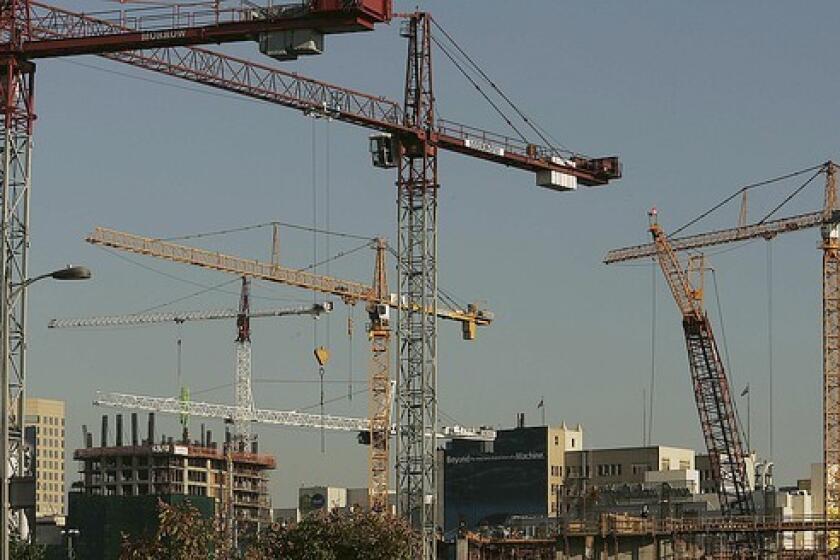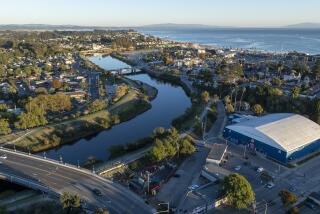A housing bill died in Sacramento. Now L.A. business leaders are exploring their own plan

One of the region’s largest business groups is exploring a new strategy for tackling Southern California’s housing crisis: asking Los Angeles voters to upzone sections of the city, allowing larger and taller residential buildings on commercial boulevards and in other areas.
Policy experts at the Los Angeles Area Chamber of Commerce have spent weeks poring over ballot language to double the density of residential buildings allowed on commercial streets and in areas zoned for apartments.
In exchange for those increases, developers would incorporate affordable housing into their projects and pay a new “affordability fee,” which would go toward assisting rent-burdened Angelenos, according to promotional materials circulated by the chamber.
The ballot proposal is being discussed weeks after Sacramento legislators rejected Senate Bill 50, which would have allowed the construction of mid-rise apartments near job centers and mass transit, including in single-family neighborhoods. State senators representing Los Angeles County opposed the bill almost unanimously.
Unlike SB 50, the proposal being discussed by chamber leaders would leave single-family neighborhoods untouched, according to drafts of the proposal.
Maria Salinas, the chamber’s president and chief executive, said her organization’s work on the ballot proposal is preliminary, with chamber officials also discussing such options as state funding.
To move ahead with a ballot measure, Salinas said, the chamber would need to build a coalition with community leaders, elected officials and others. “We are still vetting this. There are still questions. By no means is it close to a recommendation,” she said.
The Los Angeles Area Chamber of Commerce have spent weeks poring over ballot language to double the density of residential buildings allowed on commercial streets and in areas zoned for apartments.
The chamber’s executive committee is scheduled to discuss the proposal Thursday. Even if the chamber decides to pursue a ballot campaign, the group would face a tight timeline to get a proposal to voters in November.
To be guaranteed a spot on this year’s ballot, initiative backers would need to submit nearly 65,000 valid voter signatures by April 22, according to City Clerk Holly Wolcott.
That demanding schedule has left some on the chamber unsure of the best strategy for a ballot proposal.
“I like the goal of trying to move something like this forward,” said Beverly Kenworthy, vice president of the California Apartment Assn., who sits on the chamber’s board. “I just don’t know if there’s enough time” to gather signatures and mount a campaign.
The proposal, tentatively branded as the Neighborhood Protection and Affordability Initiative, is the brainchild of land use lawyer Jerry Neuman, who was the chamber board’s chairman until last month.
A promotional flier prepared by the chamber said the ballot measure would increase the allowable “floor area ratio,” or massing of a building, by up to 60% on certain properties.
The proposal also would lift height limits for commercial and multifamily residential properties, allowing buildings as tall as 75 feet — around six stories — on streets where 45 is currently permitted, according to a 20-page draft ordinance circulated within the chamber, a copy of which was obtained by The Times.
The measure also would permit buildings as tall as 55 feet on many streets where 36 is the maximum, the draft said. And it would force the city’s planning department to comply with new deadlines for completing their environmental review of residential projects, the document said.
Real estate developers would, in turn, be required to pay an affordability fee, which would go to households that are struggling to pay their rent. And developers would be required to include some percentage of affordable housing in most residential projects of 10 or more units, Neuman said.
Whether such ideas will win over tenant rights organizations is far from clear. Cynthia Strathmann, executive director of the nonprofit Strategic Actions for a Just Economy, said she worries the proposal could accelerate redevelopment and displacement of renters in L.A.’s neediest neighborhoods.
Strathmann, whose group has fought to keep low-income renters from being pushed out of their homes, said chamber leaders have not approached her with their proposal. She also questioned their commitment to addressing the effects of gentrification.
“Historically they have not been concerned with, or especially good at, attending to what is going to be good for low-income Angelenos,” she said. “So why would anyone have faith that they were going to offer the solution, and not something that’s just going to exacerbate the situation by funneling more money to the wealthy?”
Salinas disagreed with that take, saying her organization supported two ballot measures since 2016 to address homelessness. The new proposal is designed to protect neighborhoods, she said, and keeping renters from losing their homes.
Neuman’s activities at City Hall could also present political challenges. His law firm represents real estate clients who do business at City Hall, including Atlas Capital Group, which is developing a 725-unit apartment complex in Chinatown.
Renters’ rights activists have complained that the Atlas project will not offer any on-site affordable housing. City officials said Atlas had agreed to provide $2.5 million toward efforts to preserve affordable housing in Councilman Gil Cedillo’s Eastside district.
In an interview, Neuman said he has spent decades working on the issues of homelessness and affordable housing, volunteering with the United Way and several other organizations. And he argued that he should not be the focus of any effort to address the housing crisis.
“At the end of the day, it’s not about me, but about the coalition that will be created to find a workable solution to an issue that has plagued our community for far too long,” he said.









